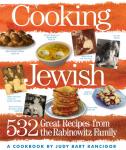
BUY COOKING JEWISH by clicking here now.
Recipes
Hanukkah Recipes
Sufganiyot (Hanukkah Jelly Doughnuts)
Stuffed Orange Sweet Potato Cups
Grandma Sera Fritkin's Russian Brisket
Splat! Potato Latkes
Cookin' for Love Malaysian Latkes with Minty Cucumber Yogurt Sauce
Honey-Drizzled Chocolate Cheese Fritters
MAIN DISHES
Merlot-Braised Short Ribs with Cipollini Onions
Chicken in Persian Pomegranate Walnut Sauce
Dja’jeh b’Ah’sal (Chicken With Prunes and Honey)
Jaffa Orange-Ginger Chicken with Baharat
Moroccan Spicy Apricot Lamb Shanks
KUGEL KORNER
Rita's Special Kugel with Toffee Walnuts
Grandma Isabelle Sheffey's Pareve Noodle Kugel
Dede Ginter's Orange Blintz Souffle
Rosh Hashanah/Break-the-Fast/Sukkot recipes
Here are some other ideas for your holiday feast.
SOUPS
Fragrant Carrot Soup with Indian Spices
BREAD
Merlot-Braised Short Ribs with Cipollini Onions
Chicken in Persian Pomegranate Walnut Sauce
Dja’jeh b’Ah’sal (Chicken With Prunes and Honey)
Jaffa Orange-Ginger Chicken with Baharat
Moroccan Spicy Apricot Lamb Shanks
SIDE DISHES
Persimmon, Pomegranate, and Pecan Salad
Libyan Couscous With Chickpeas, Squash, Zucchini and Eggplant
Baked Apples with Shallots and Herbs
Roasted Eggplant and Pomegranate Seed Salad
CLICK HERE FOR MORE HOLIDAY RECIPES
"Lindy's" Cheesecake
“Lindy’s”
Cheesecake
Serves 16 to 20
Butter, for greasing the pan
FOR THE COOKIE CRUST
1 cup all-purpose flour
1/4 cup sugar
1 teaspoon grated lemon zest
1/2 teaspoon pure vanilla extract
Yolk of 1 large egg
4 tablespoons (1/2 stick) unsalted butter, at room
temperature
FOR THE CAKE
5 packages (8 ounces each) cream cheese, at room temperature
1 3/4 cups sugar
3 tablespoons all-purpose flour
1 1/2 teaspoons grated lemon zest
1 1/2 teaspoons grated orange zest
Seating ancient and new at the same table
My column on OU's website, Shabbat Shalom includes recipes for My Chicken Marbella from "Cooking Jewish," Orange Beets with Almonds from "The Healthy Jewish Cookbook by Michael van Straten and Apricot Jelly Roll from Joan Kekst's "Passover Cookery"
Passover is the most observed Jewish holiday of the year. Even those who never step inside a synagogue pull out all the stops for this one. With our celebratory meal, the Seder, we retell the 3500-year-old story of our ancestors' flight to freedom from the land of Egypt. And everything on the table is laden with meaning.
The centerpiece is the Seder plate, holding the traditional symbols. On every Seder plate sits karpas (a green vegetable), the symbol of spring, which we dip into salt water as we remember the tears shed by our ancestors. Actually for Jews in the shtetls (little villages) in Eastern Europe, spring arrived late, and greens were rare at Passover time. "My father's family always used potato," suggested my friend Yiddish songstress Lori Cahan-Simon, "but added parsley as karpas in the new country, so we have, in effect, parsley potatoes!" Read the whole story.
Got matzoh?
The festival of Passover, which begins this year at sundown on Wednesday, commemorates the exodus of the Hebrew slaves from Egypt. Because in their haste to depart they could not wait for their bread to rise, the dough was baked in flat cakes. To commemorate our passage to freedom, Jews throughout the world eat matzo for the eight-day holiday (seven in Israel). Strict rabbinical rules govern every aspect of its production.
“Our process with our Passover matzoh,” explained David Rossi, vice-president of marketing for RAB Food Group, owners of the Manischewitz brand, “from the time water touches the flour and gets mixed, then sheeted, made thinner and thinner, to the end of baking in the oven – can be no longer than 18 minutes. If there is a mechanical failure or some issue or error where the matzoh did not get through that run in 18 minutes, then the whole run must be thrown away.”
Before the company can begin production for Passover, the entire facility must be thoroughly cleaned and inspected – a procedure that makes Mama Hinda’s routine seem like a light dusting.
“The process takes four to seven weeks,” Rossi noted. “All the belts, all the lines, all the motors, all the ovens are cleaned and kashered (made kosher) to meet strict rabbinical standards for Passover.”
Turning out hundreds of Passover items, in addition to 10 varieties of matzo – spelt is Manischewitz’s new flavor this year – is no overnighter. “We begin making Passover products in September until early March for the following year,” Rossi noted. “Because the plant is kashered at tremendous expense, we produce Passover products until we’ve run all the requirements for the year. Then in March we start making non-Passover products.”
Verne Wagner’s Poppy Seed Bread
3 cups flour
2 3/4 cup sugar
1 1/2 teaspoon baking powder
1 1/2 teaspoon salt
3 large eggs
1 1/2 cup milk
1 1/2 cup oil
6 tablespoons poppy seeds
Thanksgiving - if it ain't broke, don't fix it!
I’m scared. I’ve been toying with the idea of making all new dishes for Thanksgiving this year, but I keep hearing that old mantra in my head: “You don’t mess with Thanksgiving!” Why fix something that’s not broken?
Former long-time Fullerton resident, Linda Gomberg, seconds the notion. The five Gomberg children and their four spouses, plus 12 grandchildren, will gather in the Gomberg home, as they do every year, to enjoy a menu that seldom varies.
“One time I switched out and bought a different kind of squash for my apple stuffed squash, and they went crazy,” she recalled. “I have so many people, and they all know what to expect.”
Daughter-in-law Glenda will bring the mashed potatoes. Daughter-in-law Carolyn will make her fat-free, sugar-free pumpkin pie. Linda will serve two kinds of stuffing with homemade croutons.
“I stuff the bird with giblet stuffing and make an extra vegetable stuffing with no drippings for my vegetarian granddaughter,” she added.
“(Husband) Ray likes candied sweet potatoes, and I love turkey, especially the wings. I buy extra wings and legs and have been making it the same way for forty years.” Green beans with almonds rounds out the menu.
“We’ve got one diabetic, one fat-watcher, various weight-conscious people and a vegetarian,” Linda noted.
The weight-conscious will need all their will power to resist the desserts: “I’ll make a chocolate fudge pie, pecan pie, key lime pie, and I always do a chocolate chip bundt cake. I buy a sugar-free apple or cherry pie.”
But Thanksgiving dinner is just the beginning of the Gomberg celebration. On Friday the whole gang (all 23 of them) will take off for Desert Springs, leftovers in coolers, as they have been doing for years, for a weekend of family fun. Full story with recipe
Cranberry-Fig Chutney with Cinnamon and Pistachios
Okay I lied. I did make one new dish and it is in the freezer as we speak. I didn't add the pistachios - I will do that last minute.
The original recipe was from Julie Sahni, but I combined it with a bunch of things I saw in other recipes. Julie called for a whole teaspoon of cayenne. I used 1/4 teaspoon and it still has quite a kick, so I'm suggesting you start with 1/8. I added the lemon juice, honey, pomegranate molasses, preserves and cumin and substituted apricots for the raisins. Sahni has you cook the pistachios in the chutney but I like the crunch of adding them last minute. Also, it was my idea to saute the shallots first. That little bit of margarine gives a nice flavor. Anyway, I thought it was delicious!
Here's the recipe:
Cranberry-Fig Chutney with Cinnamon and Pistachios
makes about 7 cups
Yams or sweet potatoes? Sweet confusion!
Thanksgiving is around the corner, and even those who count the can opener as their favorite (and only) kitchen tool are planning to pull out all the stops for this feeding frenzy of a holiday. Decisions, decisions, decisions. Fresh turkey or frozen. Free range or…not. To brine or not to brine. And that’s just the main dish. Come to the side of the plate, and the real confusion begins. What on earth is the difference between sweet potatoes and yams? Well, when it comes to potatoes I know whom to turn to.
Distinguished cookbook editor Roy Finamore, with Fine Cooking magazine's Molly Stevens, offers 300 exciting, spud-studded recipes from appetizers, soups and salads through main courses, breads and even desserts in One Potato, Two Potato (Houghton Mifflin), an encyclopedic, lavishly photographed guide to everything you ever wanted to know about this humble vegetable.
Sweet potatoes, botanically unrelated to the potato, but included in the book nonetheless, are often mislabeled as "yams," Finamore explains. The true yam is more like the potato and not nearly as sweet as the sweet potato. Its texture upon cooking is also more like that of the potato, rather than the custardy texture of the sweet potato. Chances are your candied “yams” are really candied sweet potatoes.
“It’s an American thing, this confusion,” writes Finamore, who credits vegetable authority Elizabeth Schneider for tracing the mix-up to the African slaves, who began calling the American sweet potato “yams” because of their resemblance to the yams they remembered back home. “But the resemblance ends there,” continues Finamore. “Yams and sweet potatoes come from different families and have different flavors and different uses.” Full story with recipe

